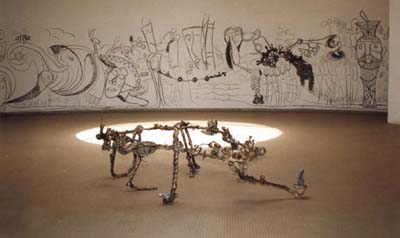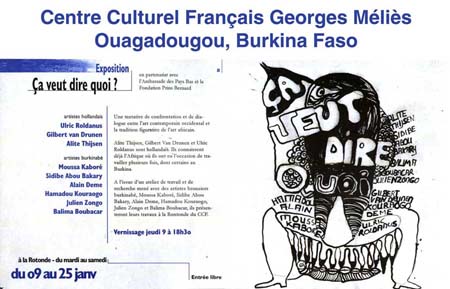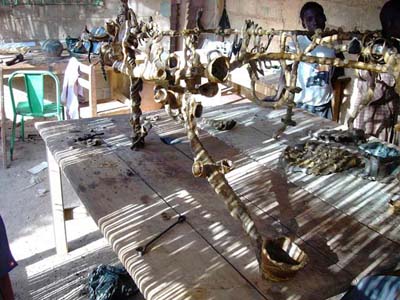article momentanément disponible en anglais uniquement
In the Netherlands, interest in African art and history focuses on South Africa, in particular the heritage of the Dutch settlers in South Africa, and their not-always-subtle role in that country’s history. « Apartheid » is one of the few Dutch words known internationally. The Dutch relationship with South Africa has always been complicated. During the Apartheid regime, several groups in the Netherlands supported the ANC. These groups are united in the Dutch Institute for Southern Africa. The multimedia exhibition Kwere Kwere – Journeys into Strangeness, curated by Rory Bester and first showed in Kaapstad and Johannesburg, reflects the institute’s political path (NIZA). The exhibition in Arti and Amicitae (Amsterdam) presents a historical view on emigration and identity. The main subject is the emigrant as a victim of social circumstance. It very much concentrates on black identity, which is, in my opinion a statement that does not reflect the complexity of the South African society. One of the most remarkable videos is To walk naked (1990) by Jaqueline Maingard, Sheila Meintjies and Heather Thompson. In this video, women try to protect from government violence the houses they have built and their last effort is to stand naked in front of the bulldozers. The message in this exhibition is overwhelming but it ends up disappearing into the mass of information. It is a pity that there is so little attention paid to the imagination of individual artists like A. Yar and Malcom Payne. Theirs is a very poetic piece about identity with lines representing a man disappearing into the dark. Another exhibition is Group portrait of South Africa, nine family histories at the Royal Tropical Institute in Amsterdam, showing to 21 September 2003. This exhibition focuses on the future to a far greater extent. It portrays a complex past and a potentially rich country, a land full of promise for the future. Personal experience provides different perspectives from history books and the news. As most people cannot resist entering other people’s lives in one way or another, it is always interesting to be invited into a family story. One of the families portrayed is the family of the famous South African jazz singer Dolly Rathebe.
From a artistic point of view, the most interesting exhibition is Guess Who, a
presentation of guests of the Thami Mnyele Foundation in the Stedelijk Museum, Zwolle. The Thami Mnyele Foundation is also rooted in the Dutch anti-apartheid movement. This is a tribute to the South African artist, Thami Mnyele, who died in the anti-apartheid struggle. The Foundation’s main purpose is to encourage cultural exchange. The foundation was founded to give South African artists an opportunity to work in tranquillity and to become acquainted with European culture. The Thami Mnyele Foundation provides a studio and artists receive a grant for living expenses and materials. The Foundation organizes meetings and exhibitions for artists selected. Since the end of the Apartheid regime, the Thami Mnyele Foundation no longer solely focuses on South Africa but also invites artist from other parts of Africa, including Dominique Zinkpe, Samson Kambalu (Malawi), Krishna Luchoomun (Mauritius). Guess Who presents works of some of the artists sponsored by the Foundation over the last five years. Krishna Luchoomun presents an installation called Yellow Pages, which constitutes his comment on the enormous waste of goods he witnessed during his stay in Amsterdam. Ina van Zijl is a South African painter. When she first came to the Netherlands her work was based on art strips comprising charcoal drawings with a comment on daily life in South Africa. She contributed drawings to the South African art strip magazine Bitterkomix. After her guest residence she continued her study at Ateliers, a postgraduate art institute in Amsterdam. In her latest drawings and paintings she concentrates on details such as shoes. Portraits painted by Mustafa Maluka (South Africa) are very colourful and on first impression seem rather harmless and influenced by Hiphop and graffiti-street culture. South African artist Senzeni Marasela made a very nice piece for the Hortus Bortanicus in Amsterdam, comprising 300 bottles filled with embroidered handkerchiefs with quotations from people who spoke at the Truth and Reconciliation Commission. Samson Kambalu contributes an interesting football piece in the form of soccer balls literally covered with bible texts – a suitcase full of paper footballs as a metaphor for the earth spirit. Last but not least, Dominique Zinkpe presented his bed in a comment on the advantages and collapse of development aid with one of his fibre figures representing the African condition.
www.thami.mnyele.nl
www.museumzwolle.nl
www.tropenmuseum.nl
www.nizan.nl
Supplement:
PostBorderLand
PostBorderland is an exhibition of African artists in Amsterdam, including Miquel Petchovsky (Angola/Portugal), Isaac Carlos (Angola), Sokari Douglas Camp (Nigeria), Moshekwa Langa (South Africa), Owusu Ankomah (Ghana), Dominique Zinkpe (Benin). The artists are of African origin but mostly live in Europe. Isaac Carlos and Moshekwa Langa studied at the Rijksakademie and resided in Amsterdam. The title does suggest that the world is without borders. The artists are selected because of their common African roots and the references to their heritage in their work. The diversity of the work shows that there is no standard for Contemporary African Art. Photographic works by Miquel Petchovsky are a reflection on his African roots in relation to his current environment. He is a transformer and likes to take objects out of their obvious context. Dominique Zinkpe’s Main d’oeuvre malgré Tout is a comment on Western development aid to Africa. A Dutch version of the Taxi Brousse portrays the complex relationship between African emigrants and their homeland. This piece is part of Domnique Zinkpe’s larger Taxi Brouse, Benin, Niger, Senegal project. Sokari Douglas Camp’s open iron images reflect rituals from her hometown in the Eastern Niger Delta in Nigeria. Her smallest piece is an iron woman carrying a glass landscape with her own kind of serenity. The Ghanaian artist Owusu Ankomah was not interested in his African roots before moving to Bremen, Germany. Owusu paints bodies reflecting the
renaissance male ideal. In his later works, these bodies disappear in a black-white patchwork of Ghanaian traditional Asanti symbols and signs. In his drawings, photographs and installations, Moshewa Langa creates his own language without geographical borders. Mutual comprehension and understanding has no borders and meaning is international. Isaac Carlos works is based on electronic waste material. Computer tabs are the basis for these electronic wasteland pieces depicting landscapes that are neither quite two- nor three-dimensional. They contain a beauty that requires close study in order to understand their context. Another piece, Purification of Isaac Carlos is a kind of comment on the title Post BorderLand. An X-ray image of a human appears behind a mirror, with a light moving vertically. Here, geographic and ethnic boundaries disappear. Perhaps the exhibition shows that there is no such a thing as an African artist but rather simply artists trying to create their own world in their own way. www.sbk.nl
///Article N° : 2891











